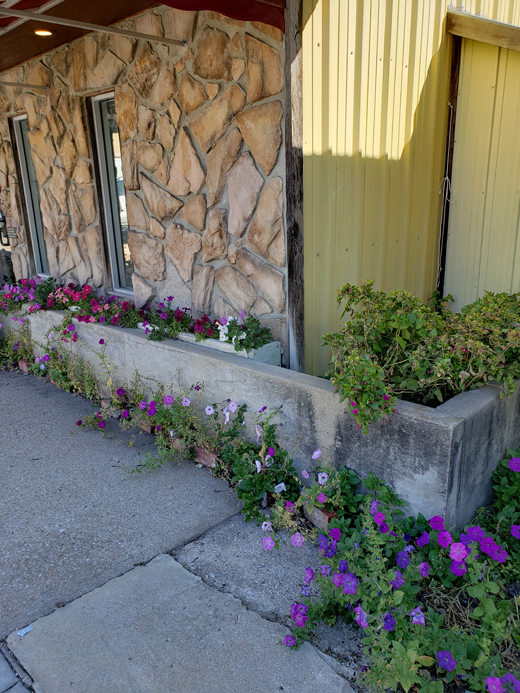Mitigation Strategy
Construct a floodwall barrier
Overview
A floodwall, also known as a perimeter engineered barrier, is a structure engineered to prevent floodwaters from reaching and inundating a structure(s) located behind the wall. Floodwalls are typically made of reinforced concrete and range from one foot to well over ten feet in height. For safety, however, it is recommended floodwalls not exceed five feet. Unlike a levee, which requires a significant horizontal area, a floodwall does not take up much space and can be used in deep, rapidly flowing water.

Floodwalls are useful in preventing flood damage to individual or groupings of structures, without altering the structures. A floodwall can surround an entire structure or protect individual doors, windows, or basement entrances. They may be automatic (passive) or may need to be closed manually before a flood event. If a floodwall requires manual closure, someone will need to be onsite to close any floodwall openings to ensure the property is protected; if a floodwall gate is left open, the floodwall will be ineffective. It’s important to note that in a severe flood, a floodwall can fail due to floodwaters overtopping the wall or the force of the water exceeding what the floodwall is built to handle.
If you are not able to elevate or relocate, floodwalls are often an effective alternative. Depending on your needs and budget, they can be designed as an attractive feature to a residence – utilizing decorative bricks or blocks, landscaping, and garden areas – or they can be designed for utility. Floodwalls can impact the flood drainage on neighboring properties, and may not be allowed in some communities. To minimize damage to your property and your neighbors’, floodwalls require engineering analyses as well as detailed operation and maintenance plans.
Property Characteristics
Property Scale
Single Property
Neighborhood
Real Estate Type
Single-family residence
Business
Government building
Foundation Type
Crawlspace
Basement
Open Foundation
Slab-on-Grade
Property Location
Non-coastal
Past Flood Depth
Shallow
Moderate
Debris Flow Potential
Yes
Structure Condition
Fair-to-excellent condition
Implementation Factors
Annual Maintenance Required
Low
Action Required If Flood Is Imminent
Yes, Active
No, Passive
Relative Cost
$$$$
$$$$$
Level of Effort
Professional
DIY

Next Steps:
- If you do not already know, contact your local government to learn more about your property’s flood history and base flood elevation, and to determine what federal, state and local permitting, code or ordinance requirements you will need to follow, before any work starts. If you are not sure who to talk to, check out our “who to contact” page.
- Contact a local registered engineer to inquire about the installation of a floodwall. If you choose to move forward, you will need the engineer to perform an engineering analysis and provide you with a detailed operation and maintenance plan.
- Once you have your engineering plans, contact a local contractor to build the floodwall. Make sure to contact your local government to ask about necessary permits before any work starts, or have your contractor do so. If you have the knowledge, you may be able to install your own floodwall; hiring a professional, however, is recommended.
- Once your floodwall is installed, perform the required maintenance in line with your maintenance plan. If your gate system is manual, make sure to have plans in place to close the gate in the event of a flood.
Special Considerations:
- Local zoning and building codes may also restrict use, size, and location of a floodwall. Ensure compliance with all applicable National Flood Insurance Program (NFIP) requirements and local building codes. The NFIP sets minimum standards and allows individual communities to adopt their own additional or more stringent requirements via local floodplain management ordinances, regulations, and laws.
- Contact a local flood insurance representative to learn more and get a quote, if you do not already have flood insurance. (Most homeowner’s insurance policies do not cover flood damage.)
- Be careful not to redirect water flow from your property onto another property. No adverse impact (NAI) floodplain management is an approach that ensures the action of any property owner, public or private, does not adversely impact the property and rights of others. NAI calls for any adverse impact caused by a project to be mitigated as part of the project. By following NAI principles, you can: prevent flooding from increasing or damaging others; see a reduction in flood losses over time; and avoid challenges and lawsuits over causing or aggravating a flood problem.
- Create a disaster plan. Be aware of all actions you will need to take once you receive warning of an oncoming flood event — and how much time each action will take to complete. Actions could include closing barrier gates, installing flood shields, or lowering storm shutters. Annually, inspect all removable pieces to make sure they are in good condition — and you have all necessary parts. Make sure whoever is identified to complete each action in your disaster plan knows how to perform the action, is physically able, and will be onsite. Once everything is in place to protect your home, you should evacuate to higher ground.
- Renters and those who own specific types of property may be limited in which mitigation options they can undertake or have different requirements to which they must adhere. If you are a renter or own any of the following listed property types, click through to learn more: Renter; Unit in a multifamily residence; Manufactured home; Farm/ranch; Historic property; New construction.
Reduce Flood Risk
https://www.reducefloodrisk.org/mitigation/construct-a-floodwall-barrier/
Printed: 05/19/2024




